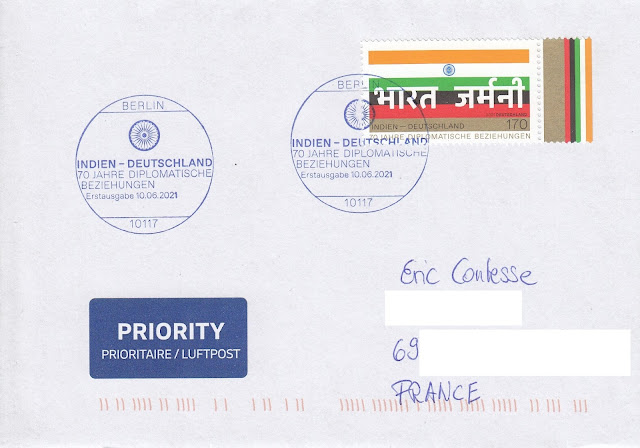Série "Costumes traditionnels", commune avec l'Inde, sur lettre de Roumanie
Les relations diplomatiques entre l'Inde et la Roumanie ont été établies le 14 décembre 1948, la Roumanie ayant ouvert une ambassade à New Delhi en 1955 et l'Inde à Bucarest en 1957.
Afin de célébrer (presque) le 75ème anniversaire de l'établissement de ces relations diplomatiques et le 10ème anniversaire de la signature de la Déclaration commune concernant un partenariat élargi, les administrations postales de la Roumanie et de l'Inde ont mis en circulation, le 17 septembre 2024, une série commune (2 timbres) illustrant des costumes traditionnels des 2 pays.
La version roumaine de cette série commune (tirage : 32978), conçue par Mihail Vămăşescu et Jairaj T.G., a été utilisée sur la lettre ci-dessous envoyée le 25 septembre 2024 depuis la ville de Voluntari (nord de Bucarest). Merci beaucoup Mihnea !
A noter que ces 2 timbres ont été imprimés chacun en feuille de 32 timbres, en feuillet composé de 5 timbres + 1 vignette ainsi que dans un même bloc-feuillet.
Diplomatic relations between India and Romania were established on December 14, 1948, with Romania opening an embassy in New Delhi in 1955 and India in Bucharest in 1957.
In order to celebrate (almost) the 75th anniversary of the establishment of these diplomatic relations and the 10th anniversary of the signing of the Joint Declaration on an Enlarged Partnership, the postal administrations of Romania and India have put into circulation, on September 17, 2024, a joint series (2 stamps) illustrating folk costumes of the two countries.
The Romanian version of this joint set (print run: 32,978), designed by Mihail Vămăşescu and Jairaj T.G., was used on the cover below sent on September 25, 2024 from the city of Voluntari (north of Bucharest). Thank you very much Mihnea!
Please note that these two stamps were each printed in a sheet of 32 stamps, in a sheetlet composed of 5 stamps + 1 label as well as in the same souvenir sheet.
Le timbre à gauche (4 L) montre un couple indien avec une femme portant un costume de cérémonie Lehenga Choli composé d'une jupe et d'un chemisier. À la longue jupe plissée, généralement brodée, s'ajoutent un chemisier coupé pour épouser la forme du corps et un élément représentant un tissu (odhani), richement décoré d'éléments floraux, qui amplifie l'élégance du costume.
Le costume masculin se compose du dhoti (semblable à un pantalon) et du kurta, une chemise ample sans col traditionnellement en coton ou en soie.
L'autre timbre (6 L) représente un couple portant un costume originaire du județ de Bihor, situé dans la nord-ouest de la Roumanie, proche de la frontière avec la Hongrie. Le costume féminin est composé d'un chemise (spătoi) et de jupes (poale) plissées à la taille, avec plusieurs volants. Le long foulard en cachemire (basma) et le suman (long manteau en laine) complètent le costume.
Le costume masculin est constitué d'une chemise courte, d'un pantalon large et d'un tablier en tissu (zadia), comprenant également un chapeau d'astrakan et des bottes longues.
The stamp on the left (4 L) shows an Indian couple with a woman wearing a Lehenga Choli ceremonial costume consisting of a skirt and a blouse. In addition to the long pleated skirt, usually embroidered, there is a blouse cut to fit the shape of the body and a fabric element (odhani), richly decorated with floral elements, which amplifies the elegance of the costume.
The men's costume consists of the dhoti (similar to trousers) and the kurta, a loose, collarless shirt traditionally made of cotton or silk.
The other stamp (6 L) shows a couple wearing a costume originating from the county of Bihor, located in northwestern Romania, close to the border with Hungary. The women's costume consists of a shirt (spătoi) and skirts (poale) pleated at the waist, with several flounces. The long cashmere scarf (basma) and the suman (long wool coat) complete the costume.
The male costume consists of a short shirt, wide trousers and a cloth apron (zadia), also including an astrakhan hat and long boots.


















